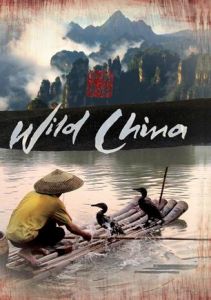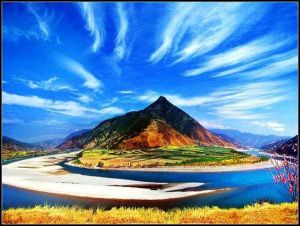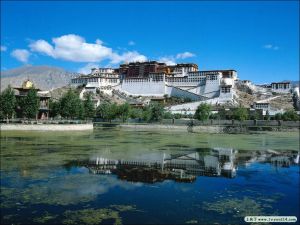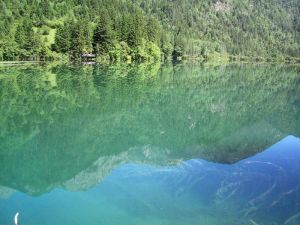美丽中国
《美丽中国》是由中英联合摄制小组拍摄的一部关于中国野生动物和自然风光的系列记录片,其中有些野生动画和风景的镜头从未在银幕上出现过。这部系列片将成为中英两国联合电视制作的一个里程碑,片名为《美丽中国》,在北京的一个典礼上上映,现场观众有幸对这一将成为经典之作的记录片投以惊鸿一瞥。
《美丽中国》由世界闻名的英国BBC自然历史制作小组和中央电视台影视制作主力——中视传媒——合作制作。该片也是BBC和中国电视台的首次合作。
《美丽中国》将全部以高清晰度方式拍摄,将使观众置身于中国的多彩风光中,包括汉代宫殿、蒙古草原和维吾尔的沙漠、丝绸之路、青藏高原。影片还包括罕见的大熊猫和一种珍稀的中国特有的食鱼蝙蝠的珍贵生活记录。
英国驻华大使欧威廉爵士在谈到这一系列片对中英两国关系的重要性时说:“《美丽中国》是一部具有空前雄心壮志的自然历史系列片。该片的成功拍摄及制作不仅是两国电视节目制作合作的成功,也是中英两国创意产业领域的一次成功合作。”
Wild China is a six-part nature documentary series on the natural history of China, co-produced by the BBC Natural History Unit and China Central Television (CCTV) and filmed entirely in high-definition (HD). It was screened in the UK on BBC Two from 11 May to 5 June 2008.[1] The English narration was provided by Bernard Hill and the series produced by Phil Chapman for the BBC and Gao Xiaoping for CCTV. The Chinese version was broadcast under the title Beautiful China. In Canada, it was broadcast on CBC as part of the series The Nature Of Things narrated by David Suzuki.
The musical score to accompany the series was composed by Barnaby Taylor and is performed by Cheng Yu and the UK Chinese Ensemble.[2]
The series is the culmination of the BBC Natural History Unit's "Continents" strand and was preceded by Wild Caribbean in 2007.
Wild China is currently broadcast in Australia on ABC1, also with a new DVD or Blu-ray Disc release are distributed via ABC DVD from Roadshow Entertainment.
【影片原名】BBC Wild China
【中文译名】BBC 美丽中国/锦绣中华,野性中国
【出品公司】BBC CCTV 中视传媒 Travel Channel
【出品年代】2008 年
【国 家】中国/英国
【类 别】记录片
【主 演】Bernard Hill
【影片长度】59:00+58:54+58:04+58:56+58:57+59:03
【对白语言】英语
《美丽中国》由世界闻名的英国BBC自然历史制作小组和中央电视台影视制作主力——中视传媒——合作制作。该片也是BBC和中国电视台的首次合作。 《美丽中国》将全部以高清晰度方式拍摄,将使观众置身于中国的多彩风光中,包括汉代宫殿、蒙古草原和维吾尔的沙漠、丝绸之路、青藏高原。影片还包括罕见的大熊猫和一种珍稀的中国特有的食鱼蝙蝠的珍贵生活记录。 英国驻华大使欧威廉爵士在谈到这一系列片对中英两国关系的重要性时说:“《美丽中国》是一部具有空前雄心壮志的自然历史系列片。该片的成功拍摄及制作不仅是两国电视节目制作合作的成功,也是中英两国创意产业领域的一次成功合作。” 在覆盖着薄薄白雪的山涧中,负责拍摄《美丽中国》的中英两国摄影师已经在这里埋伏了好几天。他们把帐篷搭在野生熊猫经常出没的地方,几个人守着42倍镜头的长焦摄影机轮流值班,但之前的每次几乎都以失败告终。“我们最想拍到的,是野生熊猫交配的镜头。”小路说,野生熊猫在交配期间非常谨慎,人们很难知道确切的交配方位。所以长时间以来,拍摄野生熊猫的交配场景是一件几乎不可能完成的任务。 但随着小路和同事扛着沉重的摄像机飞奔到拍摄地点,在长焦镜头中人们看到,树上有一只年轻的母熊猫正在不断发出叫声,而树下正有一头雄熊猫围着树“求爱”。几个小时后,另一头雄熊猫被叫声吸引而来,两头雄性在一番连咬带抓的搏斗之后,“后来者”悻悻而去。而树上的母熊猫也最终被战斗中的勇士掳获了芳心,不一会儿就从树上爬下来,乖乖地趴在石头上等待交配。就这样,一段无比珍贵的野生大熊猫野外交配的影像永远留在了《美丽中国》的胶片中。这部历经三年拍摄成功的6集纪录片,由英国BBC环球公司和中国中视传媒股份有限公司联合摄制,将于北京奥运会前夕在央视首播。 影片中,从秦岭的大熊猫、西藏的野牦牛、内蒙古的绿色草原,到云南壮观的稻米梯田,这个里程碑式的系列片真实记录了中国大地的美丽风光和动植物的丰富多样性。 BBC环球公司首席执行官史约翰先生说:“我们很自豪地将这个宏伟的系列片介绍给世界各地的观众,所有镜头都是高清拍摄。” 由中视传媒与英国BBC环球公司合作拍摄的6集高清系列纪录片《美丽中国》即将投放市场,有望继《行星地球》之后再度引发热潮。 全片拍摄中国50多个国家级野生动植物和风景保护区、86种中国珍奇野生动植物和30多个民族生活故事,展现中国自然人文景观。 “在奥运会开幕之前,这样的纪录片非常有意义,可以向全世界推广中国的美丽,让全世界的人了解中国的自然历史。”中视传媒股份有限公司董事长高小平为即将投放市场的大型高清系列纪录片《美丽中国》(Beautiful China)激动不已。
《美丽中国》分为“富饶华南”、“彩云之南”、“青藏高原”、“长城以外”、“龙之疆域”、“喧闹海岸”6集,由中央电视台控股的中视传媒(CTV)与英国BBC环球公司合作拍摄,时间总长约6个小时,制作历时3年,摄制组踏过了26个省、自治区和直辖市,拍摄了50多个国家级野生动植物和风景保护区、86种中国珍奇野生动植物,以及30多个民族的生活故事。从极北的赫哲人的生活到桂林的船上人家,从中华民族标志性建筑长城到西南边陲的苗族村寨,从青藏高原的藏羚羊到秦岭的野生大熊猫,再到云南的亚洲象……不论是风土,还是人情,都呈现在6个小时的全景描述中。
BBC环球公司总裁史约翰(John Smith)对《美丽中国》的全球发行充满信心:“在今年2月的英国广播公司节目展示会上,我们向世界各地的560个买家隆重推荐了这个特别的系列节目。目前,它已经成为BBC自然历史类节目当中头号被关注的对象,来自德国、澳大利亚等25个国家的频道已经购买了播出权。”史约翰认为,《美丽中国》将成为2006年在全球引发热潮的《行星地球》(Planet Earth)的后续者。《行星地球》不但在世界各地的电视网络获得了极高收视率、有良好的DVD销售成绩,也席卷了当年艾美奖纪录片类的几乎全部奖项。
“《美丽中国》的制作费大约是500多万英镑。”在史约翰看来,这一制作成本在纪录片中已属非常高。“我们专门购置的航拍等昂贵的设备还不算在内”,但高小平算下账来,觉得并不亏:“我们需要这样一部全面反映中国风土人情的片子,和BBC合作,我们也可以学到很多。而且,通过这次拍摄,我们也锻炼出了一支自己的国际化队伍。” 曾经用于拍摄《行星地球》的Pole-cam高清摄影技术,能够呈现极为丰富细腻的影像。 “这样的摄影机全世界没几台,我们专门带了一台过来。”纪录片总制片人连拜恩(Brian Leith)如数家珍地细数他们用来拍摄各种“不可思议”的镜头的“精密武器”:“我们还带了超高速摄影机,可以拍出比一般摄影机快80倍的镜头。比如一条蛇捕捉鸟的镜头,平常人可能根本都察觉不到这个过程,因为实在太快了,但是用这种超高速摄影机,就可以捕捉到蛇和鸟在这个过程中一帧一帧的详细过程。还有树叶发芽、树枝成长的镜头,用的是专门的延时摄影技术,可以快速地呈现一片森林的生长和变化。”此外还有水下摄影机捕捉中国南海下美丽的珊瑚礁,红外摄影机在黑暗中拍摄岩洞里的黑叶猴。 “我们还拍摄到了野生大熊猫求偶和交配的全过程。对于外国人来说,这是第一次;而用高清摄影表现,我相信这也是第一次。”BBC自然历史部主管尼尔·纳庭格(Neil Nightingale)非常自豪。 呈现“野性中国” 《美丽中国》中,大约三分之一内容用于呈现中国多元的地域和民族文化,另外三分之二全部展现自然生态。开始拍摄之前,工作人员进行了大量调研,“前期调研在野生动物纪录片中的地位很重要,只有通过前期调研,才能真正确定野生动物的行为真实性、交配的准确时间和它们的活动位置,我们才会决定去哪个保护区拍摄、什么时间去、拍摄什么,等等,然后作出详细的拍摄计划。”中方制片司路如此总结调研的重要性。 司路和同事们承担了大部分调研任务。李珂也是《美丽中国》制片之一,她记得前期合作中有中英双方的调研员,“导演提出感兴趣的选题后,调研员针对各个选题做可行性和拍摄信息的调研,例如拍摄最佳时间、地点、物种特性等问题。对BBC来说,由于时差和沟通问题,从英国进行调研非常不便,所以大部分调研工作都是由中方调研员进行。”然而,他们并非专业生物生态研究者,所以专家们的意见和经验就至关重要。在调研和拍摄期间,中科院和各个自然保护区的科学家、专业野生动物摄影师等,都成为他们的顾问,“像上海水产大学的钟俊生教授,正是由于他的帮助,我们才能拍到国家一级保护动物中华鲟。”李珂回忆道。 中国的广袤与巨大,让BBC制作人员感到前所未有的震惊。“中国有15%的国土都是保护区,这让我们非常惊异,中国光保护区的面积就已经相当于4个英国了。”连拜恩使用了“谦卑”(humble)一词形容自己最直接的感受。 但这也让拍摄变得更加困难。拍摄讲述全球自然故事的《行星地球》,BBC自然历史部用了4年,而《美丽中国》的拍摄只比那少一年。3年中,连拜恩一直在“后方”BBC布里斯托制作部坐镇,“我的感觉,好像那1100多天,拍摄组一直在路上旅行,似乎路长得都没有时间拍摄。”中国的生态多样性,同样也给“对自然有不可遏制的激情”的纳庭格留下了深刻印象:“中国有继巴西和印度尼西亚之后第三多的雨林,我必须承认,看到塔克拉玛干的戈壁,再看到海南的海上森林,我才知道,原来中国是如此丰富多样的一个国家。”
拍摄之旅虽让他们饱览或壮丽或雄奇的景色,但还是会有一些意外发生,尽管对于有多年野外拍摄经验的纪录片导演菲尔·查普曼(Phil Chapman)来说,“拍摄本身并不惊险,我们基本上预见到了所有可能的意外。”在拍摄秦岭的羚牛时,摄制组遇上了一头孤独的羚牛。“如果成群活动,这种珍贵的动物是非常温和的。但离群出走的‘独牛’不同,它们性情非常暴躁,攻击性非常强。” 毕业于牛津大学动物学专业的纳庭格解释道。摄制组和它对峙片刻就迅速撤离。而让司路难以忘怀的则是在云南高黎贡山拍摄白眉长臂猿时,他们与黑熊狭路相逢,“我们被黑熊追逐了一公里山路才脱险。”李珂还记得在大连蛇岛上的拍摄,他们允许活动的范围只是一块4平方米左右的木板,木板以外,全部是蛇的领地。“在这座小岛上到处都是剧毒的蝮蛇,拍摄过程中我们的精神时刻保持紧张,每天4点起床,工作到太阳落山。”“翻车、泥石流、沙尘暴、暴风雪……”,司路记得6个外拍小组都经历了不同的“劫难”,“但现在回忆起来,一切都是值得的。”李珂欣慰地说道。 主要担纲摄影的贾斯汀·迈奎尔(Justin Maguire)和迈克·勒蒙(Mike Lemmon)都是曾为BBC、美国国家地理频道和Discovery频道拍摄过诸多精品的自由摄影师,他们周游过全球,但如此深入广泛地拍摄中国却还是第一次。勒蒙有27年野生动物摄影经验,他追拍过地球上五个大洲的壮丽日出,这次,在黑龙江扎龙自然保护区,他等待了几个星期,才拍到一个“完美的落日”——丹顶鹤在落日的万丈光辉中优雅起舞。 第一次用高清摄影机拍摄到野生大熊猫在野外的求偶和交配的全过程,让所有制作人员都非常兴奋。“对于全世界来说,大熊猫都是偶像,所以,别提我们有多激动了。据我所知,国际团队以前确实还没有拍到过这样的镜头。”即使是秦岭保护区的工作人员,开始也对他们的计划不抱太大信心。“我们都开始要绝望了,我们大概已经去了两三次,每次都至少等待一星期,但并没有拍到我们想拍的镜头。最后一次,等了10天,终于等到了一对发情期的大熊猫。”查普曼回忆道。 在《美丽中国》拍摄过程中,甚至还收获了科学上的新发现。当他们用红外摄影机拍摄岩洞里的黑叶猴的时候,发现“黑叶猴在舔食峭壁上渗出来的含有矿物质的液体”,“甚至专门研究黑叶猴的专家都是第一次发现这种现象。”司路十分兴奋。
感受“天人合一”
“中国人和动物之间的关系,确切地说,非常实在。”查普曼在广西桂林兴坪县第一次看到人们利用鸬鹚捕鱼。他和勒蒙以及中方制片在漓江的落日时分,拍摄这个过程,“坐着他们的小竹筏在漓江上漂流,真是一个神奇的经历。”同样的事情,他们在云南丽江拉市海也经历了一次。而云南的元阳梯田也一样让他们震撼:“每一寸可以耕种的土地都被利用了起来,而且具有非常悠久的历史。”在贵州雷山的苗寨,他们看到,屋檐下燕子的行为对于苗民是耕种节气的象征。 连拜恩等人将怒江称作“英雄的怒江”,而那些有勇气用一根挂索横渡怒江的人,在他们眼中则是英雄。这条奔流于怒山和高黎贡山之间的咆哮的大江,是摄制组遇到的几乎最大的挑战。“我们摄影师必须把自己捆在挂索上,紧紧抱住摄影机,拍摄汹涌的江水,”查普曼露出了笑容,“真是很刺激。”两岸居民不论男女老幼,都面色如常地从钢筋索道上一滑而过,很多人身上还抱着要拿到集市上买卖的货物,查普曼认为,他们是当之无愧的英雄。 “如果没有CTV的中方制片,我们肯定完了。”连拜恩对中国文化的多样性五体投地,“很多少数民族不说普通话,也不说广东话。”但经过沟通,他们都很享受和当地人在一起的时光。查普曼和他的团队在贵州的中洞苗寨住了两个星期,体验苗族人的日常生活。“那是一个完全住在洞里的村庄,他们还在洞里修了篮球场。我们和当地小朋友一起玩,他们篮球打得非常好!”在中国诸多乡间奔走近3年之后,查普曼对中国充满了感情:“我对乡村中国的印象就是非常多美丽的风景,和非常多友好、好客、乐于助人的当地人。” 然而,他们同样也看到了城市边缘不断遭受影响的自然环境,这让他们的拍摄更充满意义。3年的艰苦工作之后,“让全世界的人都能看到中国的美,这是我们全体工作人员的愿望。当然,让全世界的人都更加爱护我们这个地球和与我们一样生存在地球上的动物,也是我们最大的愿望。”司路这样总结道。美丽中国的摄制的意义是十分重大的,这一点是不容质疑的.中国的独特地质地貌,珍稀的野生动物,悠久的历史文化第一次较为完整地展现在世人的面前.就这样,中国走向了世界各地人们的眼睛,走进了他们的心里.许多外国人对中国十分向往,而对于中国的了解却是十分有限,这部伟大的作品的产生无疑给那些想要更多了解中国的人们增添了一个重要的方法.其实,在展现中国独特风光的基础上,这部作品还向中国人民和外国人们描述了很多社会问题.环境污染问题,生物灭绝问题,贫富差距问题等.这些问题在我们的国家是真实存在的,其实不仅仅这样的问题在我们的国家存在,在世界上也可以说是"通病"了.美丽的中国是风光和人文共同缔造的美丽,而我们始终相信,中国还可以更加美丽.随着环境保护力度的加强,和谐社会观念的深入人心,这些都让我们看到了那个让中国更加美丽的希望!
The 2008 Beijing Olympics gave the BBC Natural History Unit team the opportunity to make the first comprehensive series on China's natural history. In the run up to the Games, the Chinese government was "understandably keen to promote itself as a country worth visiting" according to BBC producer Phil Chapman. Permission for Wild China was granted in 2005, with the BBC working alongside local partners CTV, a Beijing production company closely allied to state broadcaster CCTV. The series marks the first time that CCTV has collaborated with a foreign broadcaster.
With wildlife filmmaking in its infancy in China, and a perception in the developed world of a country plagued by environmental problems, the producers hoped that the series would change attitudes in both the East and the West:
"We want the Chinese to feel proud of their countryside and wildlife, to care about it and to seek to ensure its survival. We also hope to redress the negative view of China's environment propagated in western media."
– Series Producer Phil Chapman, writing in BBC Wildlife magazine
Filming for the series took place over 16 months, and involved half a million miles of travel on 57 separate filming trips to some of China's most inaccessible and spectacular locations. The production team shot over 500 hours of HD footage in 26 of China's 30 provinces.[5]
Despite being granted unprecedented access to many remote and protected areas, one of the main challenges faced by the filmmakers was finding wildlife. Although 15% of China's territory has some form of protection, this is not a guarantee of safety for wildlife, as reserves were often found to be under-equipped and under-staffed. In addition, they encountered a lack of local expertise and specialist knowledge, as few of China's zoologists were naturalists with an interest in observing wildlife. Producers even struggled to film the courting behaviour of one of the country's commonest creatures, the rice-paddy frog.[3] Consequently, the team's attempts to find and film wildlife were not always successful.
With the support of local party officials, the producers found it easier to contact and film local people. They were particularly keen to record examples of traditional lifestyles which incorporate the natural world to give the series a cultural context. The episodes were divided by region to present the distinct cultural as well as ecological differences.
第一集 龙之心 Heart of the Dragon
1. "Heart of the Dragon"
Broadcast 11 May 2008, the first programme in the series concentrates on South China, where the climate and terrain is ideal for rice cultivation. The terraced paddy fields of Yuanyang County plunge 2000 metres down steep hillsides to the Red River valley, and are some of the oldest man-made structures in China. In a Miao household in Guizhou province, the arrival of red-rumped swallows signals the time for planting. Other creatures which benefit from the rice monoculture include little egrets and Chinese pond herons. Of the hundreds of caves beneath the limestone hills of this karst region, few have been explored. At Zhongdong, an entire community, including a school, lives in the shelter of a cave. Francois' langurs, a rare primate, use their rock-climbing skills to enter caves at night for protection. Other cave dwellers include swifts and Rickett’s mouse eared bats, filmed for the first time catching fish in the dark. Freshwater creatures are an important resource for the people of South China. The Li River cormorant fishermen now only practice their art for tourists, but at Caohai Lake, dragonfly nymphs are a unique and valuable harvest. Some delicacies, such as freshwater turtles, are vanishingly rare. Chinese alligators only survive in Anhui province thanks to dedicated conservation efforts. A troop of Huangshan macaques is shown retreating to the safety of the treetops when a venomous Chinese moccasin is spotted. After the autumn rice harvest, migratory birds including tundra swans and Siberian cranes gather at Poyang Lake.
第二集 香格里拉 Shangri-La
2. "Shangri-La"
Broadcast 18 May 2008, this episode profiles the rich biodiversity of south-western Yunnan province. Forming the eastern boundary of the Himalaya, the Hengduan Mountains have buckled into a series of parallel ridges running north-south. The Nujiang River is one of a succession of deep gorges that carve their way through the mountains. In summer, monsoon rainclouds from the Indian Ocean are funnelled up the valleys, creating a unique climate in which species from the tropics can flourish at a more northerly latitude. Yunnan’s 18,000 plant species, of which 3,000 are found nowhere else, attracted Western botanists and explorers such as Joseph Rock. In the snowbound forests surrounding the pilgrimage site of Kawakarpo (6740m), rare Yunnan snub-nosed monkeys are filmed feeding on lichen. In the Gaoligong Mountains, tropical and alpine plants grow side by side. Birdlife filmed here includes sunbirds feeding on epiphytes and the courtship display of a Temminck's tragopan. The fruiting trees attract bear macaques and black giant squirrels, whilst China’s 250 remaining wild Asian elephants forage below. A Lesser Bamboo Bat colony is filmed at their roost inside a single stem; each bat is the size of a bumblebee. A giant elephant yam flower is pollinated by carrion beetles at night. Black crested gibbons are filmed in the forests of Wuliangshan. The people of Yunnan include the Dai, Hani and Jino tribes, each of whom regard the forests as sacred and harvest them sustainably, but modern times are bringing new threats such as rubber plantations and tourism.
第三集 西藏 Tibet
3. "Tibet"
The Tibetan Plateau is the subject of the third instalment, broadcast 25 May 2008. It covers one quarter of China’s land area, but just 2.5 million people live there, the majority Tibetan Buddhists. Their religion mixes traditional Buddhism with older shamanic beliefs, and its teachings have instilled a respectful attitude to wildlife. Rare species such as black-necked cranes and Tibetan eared pheasants can benefit directly from co-existence with people. Meltwaters from Tibet’s 35,000 glaciers form large freshwater lakes including Qinghai and Manasarovar. Nesting birds here include great crested grebes and bar-headed geese. The plateau is a high altitude desert swept by freezing winds, but is also home to China’s biggest concentration of large animals. Argali sheep are seen descending hillsides to their winter grazing sites. In the Changtang, chiru are filmed congregating in the rutting season, and wild yaks are only found in the remotest areas. Predators include the elusive snow leopard and the Tibetan fox, filmed profiting from a Tibetan bear’s attempts to hunt pika. A highly lucrative "caterpillar fungus" (yatsa gunbu) is harvested from the spring ground for use as a traditional remedy. Life even clings on in the most extreme environments; the slopes of Everest are home to a species of jumping spider, whilst the unique hot spring snake survives at 4,500m by warming its body in thermal springs. The Saga Dawa festival takes place at sacred Mount Kailash and draws pilgrims of many faiths. Tibet is a fragile ecosystem; its glaciers are melting, and this will have a profound effect on the future for billions of people who depend on waters flowing from the plateau.
第四集 万里长城的塞外风光 Beyond the Great Wall
4. "Beyond the Great Wall"
Broadcast 1 June 2008, the fourth episode looks at the lands north of China’s Great Wall. Here, nomadic tribes from a variety of ethnic groups still roam, but their traditional ways of life are changing as people move to modern cities. In ancient Manchuria, the last Hezhe fisherman still cast their nets beneath the thick ice of the frozen Black Dragon River. The forests here support wild boar, which forage for walnuts in winter, and the last remaining wild Siberian tigers in China. Ewenki reindeer herders came from Siberia hundreds of years ago: now, only 30 remain. Further west lie the rolling Mongolian steppe grasslands, and at Bayan Bulak, the livestock of Mongolian horsemen share the pastures and wetlands with breeding demoiselle cranes and whooper swans. Continuing westwards, the land becomes increasingly hot and dry, turning first to arid grasslands roamed by rare goitered gazelles, and then to the Taklamakan Desert, the world’s largest shifting sand desert. Here stand ruined towns, a legacy of the Silk Road, and many yardangs, sand-sculpted rock formations. Underground irrigation canals at the Turpan oasis enable grapes to be cultivated, and red-tailed gerbils are quick to take advantage. Kazakh nomads spend the summer in the Tian Shan before descending to the Junggar Basin, an arid land bordering the Gobi Desert, to overwinter. Here their livestock shares the meagre pasture with the last wild horses on earth. A Kazahk demonstrates the 6000-year-old tradition of hunting with golden eagles. The closing scenes show the Harbin Ice Festival.
第五集 熊猫之地 Land of the Panda
5. "Land of the Panda"
The fifth instalment, broadcast 8 June 2008, features central China, home to the Han Chinese. They are the largest ethnic group on Earth, and their language Mandarin the most widely spoken. The programme looks at how the relationship between people and wildlife has changed over time. Ancient Chinese beliefs placed great importance in the harmonious co-existence of man and nature. At the beginning of China’s period of rapid economic growth, this ideal was largely forgotten. A number of political references contrast the more enlightened environmental policies of the current government with those under Chairman Mao, which led to widespread degradation. The Chinese alligator and crested ibis are two species saved from extinction by direct intervention. Other animals have benefited from ancient spiritual beliefs and customs which live on, promoting respect and reverence for wildlife: the yellow weasels and Mandarin ducks of Beijing are two such creatures. However, wildlife is still threatened by illegal poaching for food and traditional medicine. West of Beijing lie the fertile lands of the North China Plain and the Loess plateau, source of the Yellow River. Increased demand for water has changed the river’s flow, and soil erosion causes dust storms which reach the capital. Further west, the Qinling Mountains are a refuge for some of China’s rarest species including the takin, golden snub-nosed monkey and giant panda. Giant panda courtship and mating is shown, filmed for the first time in the wild. In the colourful lakes of Jiuzhaigou, unique fish swim amongst forests preserved underwater.
第六集 潮汐更迭 Tides of Change
6. "Tides of Change"
Broadcast 15 June 2008, the final programme features China’s 14,500km coastline, home to 700 million people. Despite decades of rapid urban development, it is still an important migration route for birds. Endangered red-crowned cranes depart their northern breeding grounds to overwinter at Yancheng salt marsh, the largest coastal wetland in China. Shedao Island is an important stopover on the migration route, but the resident Shedao Island pitvipers, stranded by rising sea levels, lie in ambush in the branches. A snake strikes a songbird, and another is filmed swallowing a kingfisher. All along the coast, traditional forms of cultivation allow wildlife and people to live side by side. Crops vary from seaweed and cockles in the north to prawns further south, allowing birds such as whooper swans and black-faced spoonbills to prosper. Kejia tea-growers and Hui'an women harvesting oysters are also shown. China’s rivers and seas are heavily polluted. Sewage and fertiliser washed into the Bohai Gulf cause plankton blooms, attracting jellyfish, which in China are a commercial catch. In the Yangtze estuary, the migrations of creatures such as Yangtze sturgeon and mitten crabs are being impeded by upstream dams. In the tropical South China Sea, where coral reefs are under threat, whale sharks are rare visitors. Other rare creatures filmed include Pere David's deer and Chinese white dolphins. On Hainan island, macaques are shown jumping into a hotel swimming pool, epitomising the uneasy coexistence of wildlife and people in China, and the challenge of continuing its traditional harmonious relationship with nature.
http://www.tudou.com/playlist/playindex.do?lid=6981934
附件列表
词条内容仅供参考,如果您需要解决具体问题
(尤其在法律、医学等领域),建议您咨询相关领域专业人士。
如果您认为本词条还有待完善,请 编辑
上一篇 环境保护词汇(四) 下一篇 Nobody wants to cheat





